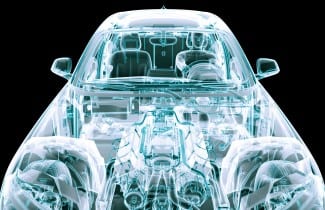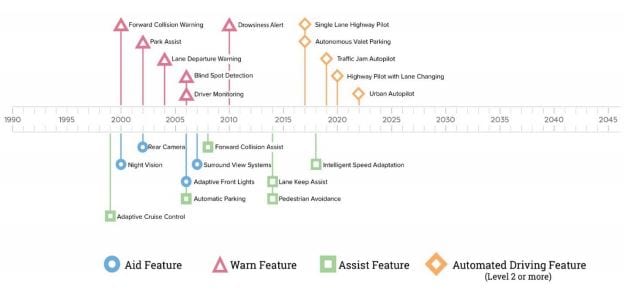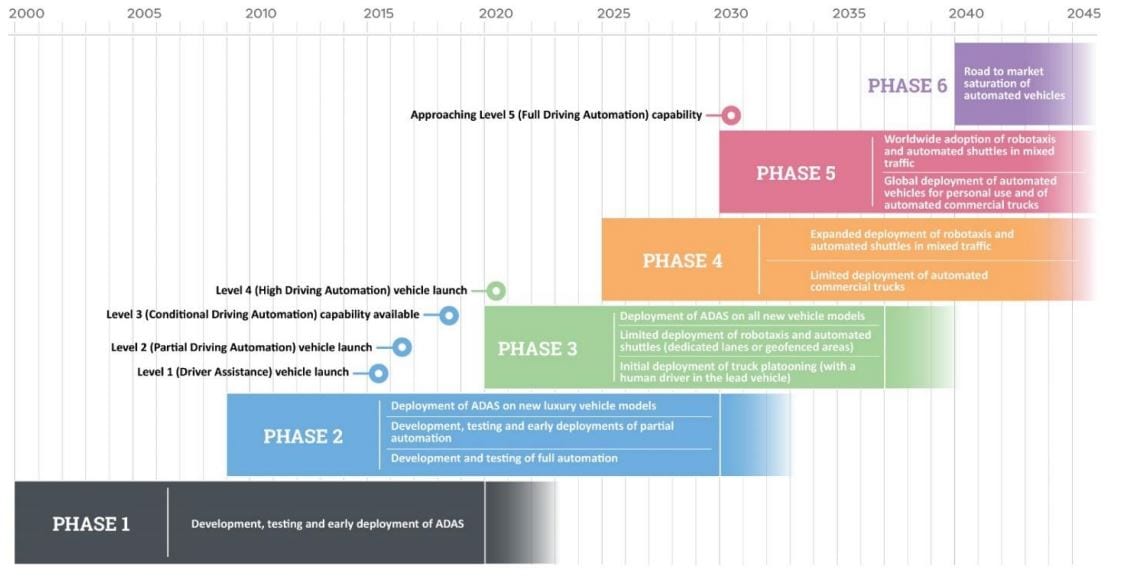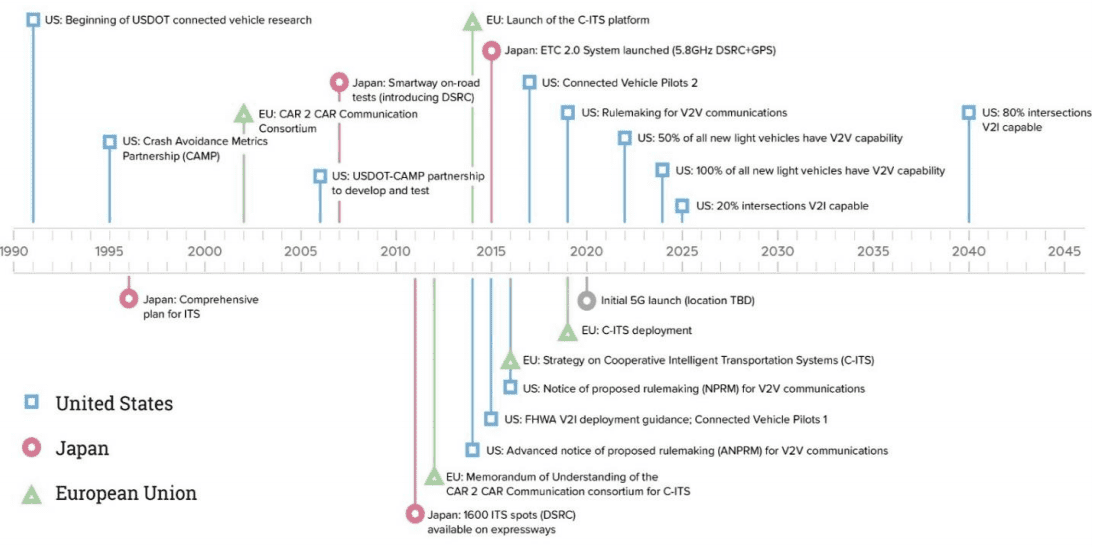Intelligent Mobility is Shaping the Future of Automotive Technology

This article is the 1st of a 3-part series on automotive trends:
- Part 1: Intelligent Mobility
- Part 2: Manufacturing Materials and Processes
- Part 3: Alternative Vehicle Propulsion Systems
Vehicle automation, connectivity, and mobility services are automotive technology trends that have been around for decades. The industry has experienced profound advancements from a significant acceleration in technology development in the last 5-10 years alone. Automated parking assists, adaptive cruise control, and automated emergency braking are becoming industry standard for new vehicles, and as the technologies continue to improve, will become seamlessly integrated in the autonomous driving experience.
As identified in a recent 2017 Technology Roadmaps report developed by the Center for Automotive Research (CAR), these are some of the most important automotive technology trends for automotive suppliers to watch in coming years. Advanced driver assistance systems (ADAS), fully autonomous vehicles, vehicle connectivity, and new mobility systems are set to radically re-define the industry as vehicle owners become more willing to automate the driving process.
Even still, there remains some resistance within automotive and technology stakeholders that could change how quickly these advanced vehicle technologies become market standard. Autonomous driving, for example, must continue overcoming technological and regulatory hurdles to succeed. Despite a growing market demand for partial or full autonomy, it could still be many years (or even decades) before these technologies achieve widespread adoption.
What is Intelligent Mobility?
Intelligent mobility is a concept used to describe the relationship between transportation systems (such as consumer vehicles) and modern technologies like cellular networks, high-powered computer processors, sensors, data fusion, and machine learning. It encompasses a wide range of consumer-facing technologies that improve the driving experience and make for safer driving conditions.
Advanced Driver Assistance Systems (ADAS)
The main focuses of advanced driver assistance systems are to warn, aid, and assist drivers while the vehicle is in operation. These systems are critical to the success of fully-autonomous vehicles, since they offer a transition period for drivers to release control and trust that the vehicle can operate on its own.

After first being introduced into 2000-2010 higher-end models, ADAS have become more common and are now available on most standard models too. Eventually, ADAS will become so common that they will be included in all new vehicles sold. While most worthwhile ADAS innovations have already been conceptualized and researched/implemented, these systems will continue being refined until they are of acceptable quality to support fully autonomous vehicles.
Fully Autonomous Vehicles
Fully autonomous vehicles remove the need for human operation as motion is coordinated through advanced GPS, sensor, and connected vehicle technologies. Opposed to ADAS, fully autonomous vehicles must be able to complete long, complex trips on its own without human interaction of any kind. Because of technological and legislative hurdles that have yet to be overcome, fully autonomous vehicles are not yet available to purchase and use on roads.

However, significant progress is being made in the development and testing of technologies. This will support the integration of new laws permitting the use of fully autonomous vehicles for certain uses. ‘Robotaxis’ and ‘automated shuttles’ are likely to be the first phase of autonomous driving implementation, with more widespread use expected by 2040.
Connected Vehicles
Connected vehicles use vehicle-to-vehicle (V2V) and vehicle-to-infrastructure (V2I) technologies to interact with its environment and remote devices. These operate on a connection to wireless networks that can send and receive information, such as voice communications (phone calls) and application data for entertainment or safety systems. Connected vehicle technologies are required for autonomous driving, but not all ADAS-enabled vehicles.

United States-based research brought connected vehicle technologies through its infancy. In 1996 General Motors released OnStar, its emergency calling feature that initiated upon the vehicle crashing. Remote diagnostics, GPS systems, and infotainment systems later came as networks could handle a greater amount of data. Future versions of connected vehicle technology will largely revolve around vehicle-to-infrastructure technologies where ‘intelligent intersections’ pass information through government-controlled devices to vehicles. This could alert drivers when they’re driving too fast, approaching a red light, or approaching an emergency services vehicle.
New Mobility Services
New or ‘shared’ mobility services encompass a range of emerging technology-driven services including ride hailing and sharing. The growth of this segment is redefining the ground transportation industry, as it uses technology to empower riders and drivers alike. Riders have unparalleled access to find and hail a ride, and can now track the location of their driver to get a sense of their up-to-the-minute ETA. Technology has also lowered entry costs for new drivers who no longer need to setup a traditional meter that only uses time and distance-based costs measurements.
While new mobility services initially started in large urban centres, they have grown to become more popular in suburbs and could even stretch to provide rural services in a relatively short timeframe. This is one of the most predominant automotive trends to keep focus on in the future as more users and vehicles look for high-quality offerings to further empower the service and make it more cost-effective.
How Will Intelligent Mobility Technologies Evolve?
The automotive technology timelines or ‘roadmaps’ provided in CAR’s report identify past milestones and future targets for testing and mass market adoption. While future predictions can never be made with complete accuracy, they offer a calculated approach that account for technological and legislative hurdles.
Each technology group has unique enabling and threatening factors that could impact the above timelines. Depending on a variety of factors, the technology’s adoption could either be accelerated or postponed.
Enabling Factors
- Advanced Driver Assistance Systems: Higher market demand for systems that automate parking and enhanced safety maneuvering.
- Fully Autonomous Vehicles: Higher market demand and investment support for the development and testing of fully-autonomous driving.
- Connected Vehicles: Public and private investment into vehicle-to-infrastructure technologies and networks.
- New Mobility Services: Increasing urban populations, expansion into rural environments.
Threatening Factors
- Advanced Driver Assistance Systems: Consumer cost-consciousness that limits the inclusion of advanced safety and automation systems.
- Fully Autonomous Vehicles: Lack of legislative support for testing and road-readiness approvals, crashes and other malfunctions while testing that limit public trust.
- Connected Vehicles: Lack of investment in vehicle-to-infrastructure networks.
- New Mobility Services: Appealing to consumers outside of rural environments, maintaining profitable ride sharing/hailing business structures.

